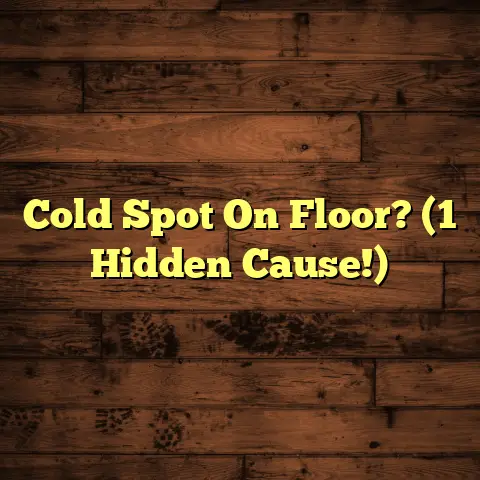(Do not rewrite this topic, as it is irrelevant.)
Imagine stepping into your home, the comforting scent of fresh paint lingering in the air.
You glide across the smooth surface of your new hardwood flooring, admiring its gleam.
But wait—what was that? A faint creak echoes beneath your feet. Your heart races as you remember the stories you’ve heard about unsuspecting homeowners who discovered disastrous flooring issues lurking below the surface. What if that creak is a sign of something more sinister? What if your dream home is hiding a flooring nightmare?
I’m Mike, and I’ve been knee-deep in sawdust and adhesives as a flooring contractor for over 15 years.I’ve seen it all, from minor scratches to full-blown flooring failures. Trust me, that comforting creak can quickly turn into a cause for serious concern.
In this article, we’re going to dive into the various flooring issues that can plague your home.
We’ll go from those minor repairs to major overhauls, understanding the intricacies of flooring problems is crucial for every homeowner.
I’ll share my insider knowledge on the common types of flooring materials, the issues that can arise with each, and step-by-step processes to diagnose and fix these problems before they escalate.
Let’s get started, shall we?
Section 1: Understanding Flooring Materials
1. Types of Flooring
Okay, so let’s kick things off by talking about the different types of flooring you might have in your home. Each material has its own personality, its own strengths, and, unfortunately, its own set of potential problems.
Here’s a quick rundown:
-
Hardwood: The classic choice. Think oak, maple, cherry, and walnut. It’s beautiful, durable, and adds value to your home.
-
Laminate: A cost-effective alternative that mimics the look of hardwood. It’s made of compressed wood topped with a decorative layer.
-
Vinyl: Super versatile and comes in sheets, tiles, or planks. It’s water-resistant, making it great for kitchens and bathrooms.
-
Tile: Ceramic, porcelain, or stone – tile is tough, waterproof, and perfect for high-moisture areas.
-
Carpet: Soft, cozy, and comes in endless colors and styles. It’s great for bedrooms and living rooms where you want a warm, inviting feel.
2. Pros and Cons of Each Material
Now, let’s weigh the pros and cons of each flooring type. This will help you understand what you’re working with and what to expect in terms of maintenance and potential issues.
| Flooring Type | Pros | Cons |
|---|---|---|
| Hardwood | Durable, adds value, beautiful, can be refinished | Expensive, susceptible to moisture, requires regular maintenance |
| Laminate | Cost-effective, easy to install, scratch-resistant | Not as durable as hardwood, can’t be refinished, susceptible to water damage if not properly sealed |
| Vinyl | Water-resistant, versatile, affordable, easy to clean | Can be dented or torn, may not add as much value to your home |
| Tile | Waterproof, durable, easy to clean, comes in many styles | Can be cold, hard, and slippery, grout requires regular cleaning and sealing |
| Carpet | Soft, comfortable, warm, reduces noise | Stains easily, requires frequent vacuuming, can trap allergens |
3. Identifying Material-Specific Issues
Each flooring material reacts differently to its environment.
Hardwood expands and contracts with humidity, laminate can warp if it gets too wet, vinyl can fade in direct sunlight, tile can crack under stress, and carpet can wear out in high-traffic areas.
Understanding these material-specific issues is key to preventing and addressing problems early on.
For example, I once had a client who installed beautiful hardwood flooring in their basement without a proper moisture barrier. Within a year, the floors were cupping and buckling due to the high humidity.
A little knowledge can save you a lot of headaches and money down the road!
Section 2: Common Flooring Issues and Their Causes
Alright, let’s get into the nitty-gritty.
Here are some of the most common flooring issues I’ve encountered over the years, and what causes them.
1. Cupping and Crowning in Hardwood Floors
-
Explanation: Cupping is when the edges of the wood planks are higher than the center, creating a concave appearance. Crowning is the opposite – the center of the plank is higher than the edges, forming a convex shape.
-
Causes: Humidity is the biggest culprit. Cupping usually happens when the bottom of the planks absorbs moisture faster than the top, causing the edges to swell. Crowning occurs when cupped floors dry out, and the edges shrink back while the center remains raised. Improper installation and water damage can also lead to these issues.
2. Buckling and Gapping
-
Understanding: Buckling is when the floor lifts off the subfloor, creating humps or waves. Gapping is when spaces appear between the planks.
-
Reasons: Buckling is often caused by excessive moisture or improper installation, where the floor doesn’t have enough room to expand. Gapping can result from seasonal changes in humidity, causing the wood to shrink, or from poor acclimation of the wood before installation.
3. Scratches and Dents
-
Common Culprits: Furniture, pets, and heavy foot traffic are the usual suspects. Dragging furniture across the floor, pets with untrimmed nails, and high heels can all leave their mark.
-
Prevention & Repair: Use furniture pads under legs, keep your pet’s nails trimmed, and avoid wearing shoes with sharp heels indoors. For minor scratches, you can use a touch-up pen or wax filler. For deeper scratches or dents, you might need to sand and refinish the affected area.
4. Warping in Laminate and Vinyl
-
How Water Damage Leads to Warping: Laminate and vinyl are more water-resistant than hardwood, but they’re not waterproof. If water seeps into the seams or under the flooring, it can cause the core to swell and warp. Once warping occurs, it’s usually irreversible.
-
Identifying Signs & Importance of Immediate Action: Look for bubbling, peeling, or uneven surfaces. If you spot any of these signs, act fast! Dry the area thoroughly and consider replacing the affected planks or tiles to prevent further damage.
5. Tile Cracking and Grout Issues
-
Causes & Effects of Cracked Tiles: Cracked tiles can be caused by impact, improper installation, or movement in the subfloor. Not only are they unsightly, but they can also be a tripping hazard and allow water to seep into the subfloor.
-
Importance of Proper Installation & Maintenance of Grout Lines: Grout fills the spaces between tiles and prevents water from penetrating. If the grout is cracked, missing, or improperly sealed, water can get underneath the tiles and cause them to loosen or crack. Regular cleaning and sealing of grout lines are essential to prevent these issues.
6. Carpet Wear and Tear
-
Identifying Signs of Aging Carpets: Fading, matting, and staining are all signs that your carpet is nearing the end of its life. High-traffic areas will often show wear and tear first.
-
Impact of Foot Traffic & Cleaning Methods: Foot traffic compresses the carpet fibers, causing them to lose their springiness. Harsh cleaning methods and chemicals can also damage the fibers and cause them to break down. Regular vacuuming and professional cleaning can help prolong the life of your carpet.
Section 3: Diagnosing Flooring Problems
Okay, so you’ve noticed something’s not quite right with your floors. Now what?
Here’s how to play detective and figure out what’s going on.
1. Visual Inspections
-
How to Conduct a Thorough Visual Inspection: Get down on your hands and knees and really examine your floors. Look for discoloration, gaps, uneven surfaces, and any other signs of damage.
-
What to Look For: Pay close attention to areas near doorways, windows, and plumbing fixtures, as these are often the most vulnerable to moisture damage.
2. Listening to Your Floors
-
Significance of Sounds: Creaks, pops, and squeaks can tell you a lot about what’s going on beneath the surface. These sounds often indicate loose nails, shifting subfloors, or friction between flooring materials.
-
Techniques for Pinpointing the Source of the Noise: Walk around the room and try to isolate the source of the noise. Press down on the floor in different spots to see if you can replicate the sound. Sometimes, having someone else walk around while you listen can help you pinpoint the exact location.
3. Tools for Diagnosis
-
Essential Tools:
- Moisture Meter: Measures the moisture content of wood and other materials.
- Level: Ensures that your floors are even and flat.
- Vacuum Gauge: Measures the suction power of your vacuum cleaner.
- A good flashlight: Helps you see clearly in dark or shadowed areas.
-
How to Use These Tools Effectively: A moisture meter can help you identify areas where moisture is penetrating your floors. A level can reveal uneven spots that may indicate subfloor issues. A vacuum gauge can help you determine if your vacuum cleaner is effectively removing dirt and debris from your carpet.
Section 4: Repair Techniques for Each Flooring Type
Alright, you’ve diagnosed the problem. Now it’s time to get your hands dirty and fix it!
Here are some repair techniques for each flooring type.
1. Hardwood Floors
-
Sanding and Refinishing: Sanding removes the old finish and any surface imperfections, while refinishing adds a new layer of protection and enhances the wood’s natural beauty. This is best left to professionals, but if you’re feeling ambitious, you can rent a sander and do it yourself. Just be sure to wear a respirator and follow the manufacturer’s instructions carefully.
-
Replacing Damaged Planks: If a plank is severely damaged, you’ll need to replace it. Carefully remove the damaged plank using a chisel and hammer. Clean the area and install a new plank using wood glue and nails.
-
Fixing Gaps: Small gaps can often be filled with wood filler. For larger gaps, you may need to insert wood shims or slivers.
2. Laminate and Vinyl Flooring
-
Repairing Scratches and Dents: Minor scratches can often be concealed with a laminate or vinyl repair kit. For deeper scratches, you can use a color-matching wax filler.
-
Replacing Planks: If a plank is severely damaged, you can replace it using a utility knife and a tapping block. Carefully score the plank and break it into smaller pieces for easy removal. Clean the area and install a new plank, making sure to align the edges properly.
3. Tile Floors
-
Replacing Cracked Tiles: Use a grout saw to remove the grout around the cracked tile. Then, use a chisel and hammer to carefully remove the tile. Apply thin-set mortar to the back of the new tile and press it into place. Allow the mortar to dry for 24 hours, then apply new grout.
-
Re-Grouting: If the grout is cracked or missing, you’ll need to re-grout the area. Use a grout saw to remove the old grout, then apply new grout using a grout float. Wipe away any excess grout with a damp sponge.
-
Solutions for Loose Tiles: Loose tiles are often caused by a lack of adhesion between the tile and the subfloor. Remove the loose tile and scrape away any old mortar. Apply new thin-set mortar to the back of the tile and press it into place.
4. Carpet Repairs
-
Patching: If you have a small area of damaged carpet, you can patch it using a piece of carpet from a remnant or a hidden area, like a closet. Cut out the damaged area and the patch, making sure they are the same size and shape. Apply seam tape to the edges of the opening and the patch, then iron the tape to bond the patch to the surrounding carpet.
-
Stretching: Over time, carpet can become loose and wrinkled. Stretching the carpet can remove these wrinkles and extend the life of your carpet. You’ll need a carpet stretcher and a knee kicker to do this properly.
-
Cleaning: Regular vacuuming and professional cleaning can help keep your carpet looking its best. Be sure to use a vacuum cleaner with a HEPA filter to remove allergens and dust mites.
-
When to Call a Professional: For large or complex repairs, it’s best to call in a professional. They have the tools and expertise to handle even the most challenging flooring problems.
Section 5: Preventative Measures
Alright, you’ve fixed your floors. Now, let’s talk about how to keep them in tip-top shape and prevent future problems.
1. Regular Maintenance Tips
-
Hardwood: Sweep or vacuum regularly to remove dirt and debris. Use a damp mop with a wood floor cleaner to clean the floors. Avoid using excessive water, as this can damage the wood.
-
Laminate and Vinyl: Sweep or vacuum regularly. Use a damp mop with a laminate or vinyl floor cleaner. Avoid using abrasive cleaners, as these can scratch the surface.
-
Tile: Sweep or vacuum regularly. Use a damp mop with a tile floor cleaner. Clean grout lines with a grout brush and a solution of water and baking soda.
-
Carpet: Vacuum regularly, at least once a week. Have your carpets professionally cleaned every 12-18 months.
-
Importance of Routine Inspections: Regularly inspect your floors for signs of damage. Address any problems promptly to prevent them from escalating.
2. Environmental Control
-
Managing Humidity and Temperature: Maintain a consistent humidity level in your home to prevent hardwood floors from expanding and contracting. Use a humidifier or dehumidifier as needed.
-
Best Practices for Cleaning and Care: Use the right cleaning products for your flooring type. Avoid using harsh chemicals or abrasive cleaners. Place mats at entrances to trap dirt and moisture. Use furniture pads under the legs of furniture to prevent scratches.
3. When to Seek Professional Help
-
Signs That Indicate It’s Time to Call a Flooring Expert: If you’re dealing with extensive water damage, structural issues, or complex repairs, it’s best to call in a professional.
-
Questions to Ask When Hiring a Professional:
- Are you licensed and insured?
- How much experience do you have?
- Can you provide references?
- What is your estimated timeline and cost?
- Do you offer a warranty on your work?
Conclusion
Well, there you have it! We’ve covered a lot of ground (pun intended!) when it comes to flooring issues and how to fix them.
As you navigate the world of flooring repairs, remember that timely intervention can save you from extensive and costly damages.
By understanding the common issues and their solutions, you can ensure that your home remains a sanctuary rather than a source of anxiety.
Don’t let the creaks and pops underfoot turn into a flooring catastrophe; take charge of your home’s foundation today.
And remember, I’m always here to help if you need a hand. Happy flooring!





